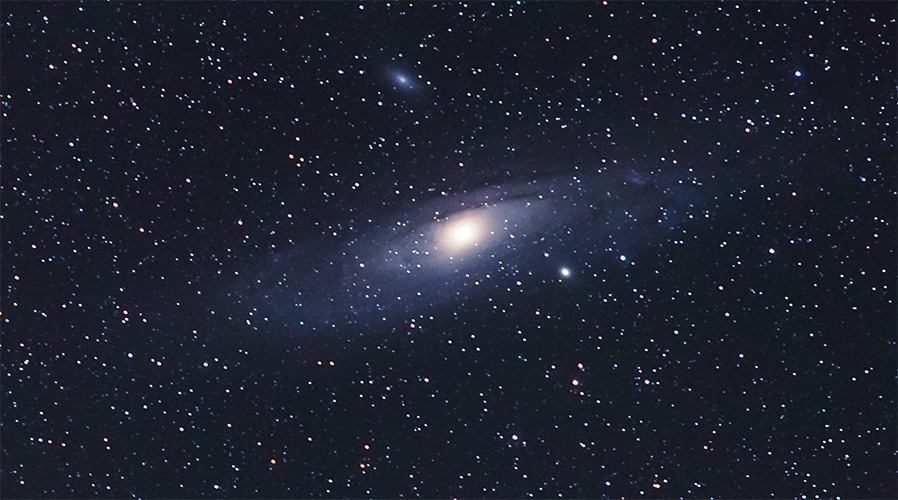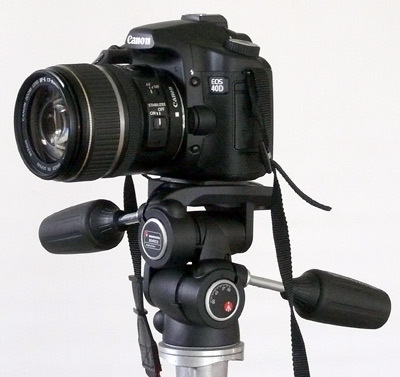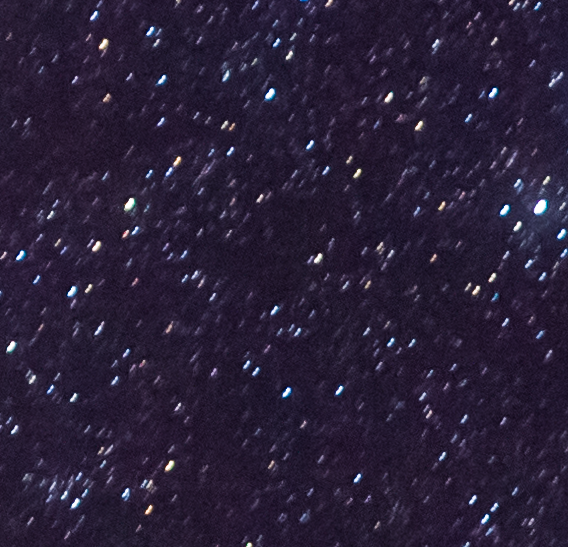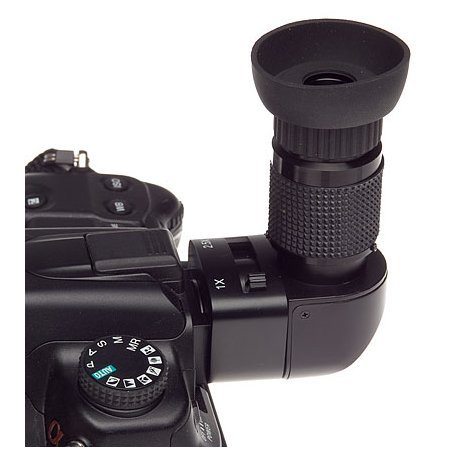Astrotracker Field Tests
In a previous post, I talked about how to make an astrotracker in two evenings. It is time to test its work and draw the first conclusions.
Here is an example of a photo taken with it:

Yesterday was the first successful night with a clear sky. I packed up and went to the cottage 15 km from Dnepropetrovsk. The distance is not sufficient to exclude flare from the city, but for the first experiments it is quite suitable.
After preliminary balcony testsI made two significant changes to the controller firmware. The first is that when the power is turned on, the engine immediately begins to rotate. This allows you to simply turn on / off the power to start the engine. And the second - changed the direction of rotation of the engine. I hid all the electronics in a black box and tried not to climb into it during the shooting so as not to light my eyes again.
On the spot, I started by trying to orient the axis of rotation of the tracker on the Polar Airship. This turned out to be the biggest problem of the whole evening.
Firstly, I had no sight. I had to look along the door canopy using the angle between it and the MDF as an aim. But this is very, very inconvenient, because I can’t keep in focus both him and the North Star.

Secondly, my tripod head is not designed for very accurate aiming at an object. There are absolutely no elements on it in order to make very precise and small rotations. Those handles that are very short on it have a small lever. And when I hung the second tripod head and a camera with a lens on the astrotracker, it turned out that a very large load with a large lever began to act on the main head, which made any exact guidance impossible in principle.
It turns out that you need to come up with some kind of mechanism for accurately pointing the tracker to the pole without using a tripod head. You also need to provide a sight.
I performed the initial setup using the gyro in the phone. I set the tilt angle to 49.2 degrees and I aimed the tracker towards the pole.
Further, I used this particular method, because nothing more accurate can be done without changing the design.
Also during the experiments it turned out that the rigidity of the structure raises a number of questions. After the shutter fires at a focal length of 200 mm, micro-oscillations occur (even with a previously raised mirror). I circumvented this by closing the lens view with my hand for a couple of first and last seconds of exposure.
I made the first test shots with the engine turned off and then with the engine turned on. The difference turned out to be significant:

F / 4, ISO 320, 75mm, 79 sec.
Here on the left is a static frame, on the right - with an astrotracker. This is the angle of the photo, scale 1: 1. Tamron 28-75 / 2.8 draws in the corners somehow not very beautiful.
But this whole frame:

Just below the center of the frame is the North Star.
Then I decided to try a longer shutter speed at a wide angle and no longer in the area of the pole where the rotation is minimal but to the side. The result impressed me:

28mm, f / 4, ISO 320, 149 sec.
Gaining courage and making an even longer exposure. I make 2 frames one by one (212 and 260 seconds, f / 3.5, ISO 320, 28 mm). I played around with them a bit in the editor and glued them together to reduce noise and increase brightness. The camera looked almost vertically upwards, so, fortunately, no glare from the neighbors got into the lens.

Oh yeah! This is what it was all about. Huge placers of stars, the Milky Way is visible, a good study of the details, no tracks. I am satisfied.
Well, this is not enough for me. I pass to 70-200 / 2.8. You have to re-adjust the tracker aiming at the pole. This time is very difficult. The weight of the camera with a lens is large. The accuracy of the sight is even less than in the previous experiment.
During the testing process, it becomes clear that so far you have to forget about shutter speeds longer than 60 seconds - the tracks will come out. But at shutter speeds per minute, everything does not look so bad. You also have to raise the ISO to 1600 to get a good exposure.

200mm, F / 3.3, ISO 1600, 64sec.
Here is a 1: 1 fragment

Next, I began to experiment with tuning to the polar star. Also, he almost completely “closed” the halves of the tracker in order to reduce hairpin hanging. During the experiments, it turned out to take several pictures of the famous galaxy Andromeda (M31). It was not easy for a beginner to find her in the sky. But the SkEye program on the phone helped. The galaxy itself, I never saw through the eyes. Induced purely on secondary grounds. But once finding her in the sky then it was already easy.
The result was a shot:

63 sec, 200mm, f / 3.2, ISO 1600
Here is a fragment on a 1: 1 scale:

After cropping, adding three frames, color grading and a bit of street magic, we got a picture from the beginning of the post:

Well, not bad for the first time.
So, summing up, we can say that the astrotracker really works. Its accuracy is enough to work even with a 200mm lens and 21MPx cameras. However, the design requires substantial refinement to improve the quality of pointing to the pole without using the head of a photographic tripod.
With the help of an astrotracker, anyone can join astrophotography. It does not require significant investment (subject to the availability of a camera, a tent, and desire), it is fun and informative.
PS Although whom I am deceiving. While I waited for each frame lasting several minutes, I was overcome by a green melancholy. I had to bring a telescope with me.
Here is an example of a photo taken with it:

Yesterday was the first successful night with a clear sky. I packed up and went to the cottage 15 km from Dnepropetrovsk. The distance is not sufficient to exclude flare from the city, but for the first experiments it is quite suitable.
After preliminary balcony testsI made two significant changes to the controller firmware. The first is that when the power is turned on, the engine immediately begins to rotate. This allows you to simply turn on / off the power to start the engine. And the second - changed the direction of rotation of the engine. I hid all the electronics in a black box and tried not to climb into it during the shooting so as not to light my eyes again.
On the spot, I started by trying to orient the axis of rotation of the tracker on the Polar Airship. This turned out to be the biggest problem of the whole evening.
Firstly, I had no sight. I had to look along the door canopy using the angle between it and the MDF as an aim. But this is very, very inconvenient, because I can’t keep in focus both him and the North Star.

Secondly, my tripod head is not designed for very accurate aiming at an object. There are absolutely no elements on it in order to make very precise and small rotations. Those handles that are very short on it have a small lever. And when I hung the second tripod head and a camera with a lens on the astrotracker, it turned out that a very large load with a large lever began to act on the main head, which made any exact guidance impossible in principle.
It turns out that you need to come up with some kind of mechanism for accurately pointing the tracker to the pole without using a tripod head. You also need to provide a sight.
I performed the initial setup using the gyro in the phone. I set the tilt angle to 49.2 degrees and I aimed the tracker towards the pole.
Further, I used this particular method, because nothing more accurate can be done without changing the design.
Also during the experiments it turned out that the rigidity of the structure raises a number of questions. After the shutter fires at a focal length of 200 mm, micro-oscillations occur (even with a previously raised mirror). I circumvented this by closing the lens view with my hand for a couple of first and last seconds of exposure.
I made the first test shots with the engine turned off and then with the engine turned on. The difference turned out to be significant:

F / 4, ISO 320, 75mm, 79 sec.
Here on the left is a static frame, on the right - with an astrotracker. This is the angle of the photo, scale 1: 1. Tamron 28-75 / 2.8 draws in the corners somehow not very beautiful.
But this whole frame:

Just below the center of the frame is the North Star.
Then I decided to try a longer shutter speed at a wide angle and no longer in the area of the pole where the rotation is minimal but to the side. The result impressed me:

28mm, f / 4, ISO 320, 149 sec.
Gaining courage and making an even longer exposure. I make 2 frames one by one (212 and 260 seconds, f / 3.5, ISO 320, 28 mm). I played around with them a bit in the editor and glued them together to reduce noise and increase brightness. The camera looked almost vertically upwards, so, fortunately, no glare from the neighbors got into the lens.

Oh yeah! This is what it was all about. Huge placers of stars, the Milky Way is visible, a good study of the details, no tracks. I am satisfied.
Well, this is not enough for me. I pass to 70-200 / 2.8. You have to re-adjust the tracker aiming at the pole. This time is very difficult. The weight of the camera with a lens is large. The accuracy of the sight is even less than in the previous experiment.
During the testing process, it becomes clear that so far you have to forget about shutter speeds longer than 60 seconds - the tracks will come out. But at shutter speeds per minute, everything does not look so bad. You also have to raise the ISO to 1600 to get a good exposure.

200mm, F / 3.3, ISO 1600, 64sec.
Here is a 1: 1 fragment

Next, I began to experiment with tuning to the polar star. Also, he almost completely “closed” the halves of the tracker in order to reduce hairpin hanging. During the experiments, it turned out to take several pictures of the famous galaxy Andromeda (M31). It was not easy for a beginner to find her in the sky. But the SkEye program on the phone helped. The galaxy itself, I never saw through the eyes. Induced purely on secondary grounds. But once finding her in the sky then it was already easy.
The result was a shot:

63 sec, 200mm, f / 3.2, ISO 1600
Here is a fragment on a 1: 1 scale:

After cropping, adding three frames, color grading and a bit of street magic, we got a picture from the beginning of the post:

Well, not bad for the first time.
10 tips for beginners like me
1. Dress much warmer than during the day. Although summer is now, but at night the temperature drops to +12 (or even lower). Sitting for a long time and still is very cold. I put on a winter down jacket, hat and gloves and still froze at the end. He went to bed at 3 in the morning, mostly because he was cold.
2. Thermos with tea and cookies. Must have.
3. Take a folding table and a white tablecloth with you. It was very convenient for me to put everything on it. In the dark, the contours of objects are visible on a white tablecloth so that it is more convenient to find what you need on it.
4. A comfortable chair. Will have to sit for a long time. Better to be comfortable. I used a beach folding deck chair.
5. Spare batteries, flash drives, camera.
6. At night, dew falls. Cover equipment and utensils with rags until you use it. Check your optics periodically. Take microfiber to wipe moisture.
7. At night, one is a little scared. You react to any rustle. I think it would be better if someone is around.
8. Turn on the mirror pre-lift in the camera. Use the trigger cable.
9. Try not to move around the tripod while the shutter speed is on. No jumps, bumps, vibrations, loud music.
10. Watch your feet. Do not catch on a tripod. It’s easy to knock the adjustment to the North Star.
11. Bonus free advice only for those who opened the spoiler.
You can use the angular viewfinder. Here is one:

It has a mode of double magnification of the picture from the viewfinder, which greatly increases the visibility of stars with the eye when sighted.
2. Thermos with tea and cookies. Must have.
3. Take a folding table and a white tablecloth with you. It was very convenient for me to put everything on it. In the dark, the contours of objects are visible on a white tablecloth so that it is more convenient to find what you need on it.
4. A comfortable chair. Will have to sit for a long time. Better to be comfortable. I used a beach folding deck chair.
5. Spare batteries, flash drives, camera.
6. At night, dew falls. Cover equipment and utensils with rags until you use it. Check your optics periodically. Take microfiber to wipe moisture.
7. At night, one is a little scared. You react to any rustle. I think it would be better if someone is around.
8. Turn on the mirror pre-lift in the camera. Use the trigger cable.
9. Try not to move around the tripod while the shutter speed is on. No jumps, bumps, vibrations, loud music.
10. Watch your feet. Do not catch on a tripod. It’s easy to knock the adjustment to the North Star.
11. Bonus free advice only for those who opened the spoiler.
You can use the angular viewfinder. Here is one:

It has a mode of double magnification of the picture from the viewfinder, which greatly increases the visibility of stars with the eye when sighted.
So, summing up, we can say that the astrotracker really works. Its accuracy is enough to work even with a 200mm lens and 21MPx cameras. However, the design requires substantial refinement to improve the quality of pointing to the pole without using the head of a photographic tripod.
With the help of an astrotracker, anyone can join astrophotography. It does not require significant investment (subject to the availability of a camera, a tent, and desire), it is fun and informative.
PS Although whom I am deceiving. While I waited for each frame lasting several minutes, I was overcome by a green melancholy. I had to bring a telescope with me.
